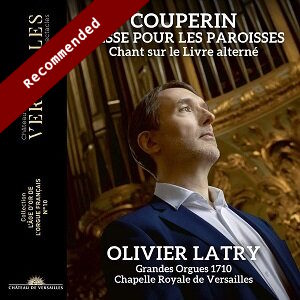
François Couperin (1668-1733)
Messe Pour Les Paroisses (1690)
Olivier Latry (organ)
Chant sur le livre/Jean-Yves Haymoz
rec. 2022, Chapelle Royale de Versailles
Château de Versailles CVS083 [66]
During the last 50 years attitudes to early music have undergone a profound change. The music is no longer adapted to the requirements of modern players and ensembles, but is regarded as having an integrity which is inviolable. However, what cannot be changed is the fact that in the 21st century those listening to early music do so with a contemporary mindset and perceptions that cannot escape the experiences of living in the modern age. More reason, perhaps, to strive for what we believe is the nearest approach to authenticity. With this new recording of Couperin’s Messe pour le Paroisses by Olivier Latry, every effort has been made to recreate the sound world of the late 17th and early 18th centuries. The organ is that of the Chapelle Royale de Versailles, built by the most distinguished organ builder of the age, Robert Clicquot, in 1711, over 20 years after the work was composed, but it was inaugurated by Couperin himself on its completion.
The Mass is presented in alternatim, where the movements played by the organ are interspersed by verses sung by cantors. This is how they would have been performed at the time, but the practice was banned by Pope Pius X in 1903 and has only been revived, at least in the concert hall, since the 1970s. Without it an organ mass would be difficult for a modern audience to comprehend. In her recordings of both Couperin Masses in 1989 on Erato (2292-45460-2), Marie-Claire Alain plays the works in extenso, which would have bemused an 18th century audience since the music was never intended to be heard in that way. Like Latry, Marie-Claire Alain uses an historic organ, the Moucherel-Formentelli instrument at the Cathédral Sainte Cécile d’Albi, but at the time it is doubtful whether it would have occurred to a record company to include the plainsong verses. The series of mostly short movements played consecutively rob the music of an important dimension.
The chant sur le livre literally ‘singing on the book’ is performed here in a perfectly understated manner by a group of young singers, directed by Jean-Yves Haymoz, which entirely suits the context of the performance where it is the organ that is centre stage. Scrupulously restored in 1995 by Jean-Loup Boisseau and Bertrand Cattiaux to its original specification, it is difficult to imagine a better vehicle for music which so depends on the sound as specified by the composer. This is not just a case of giving brief instructions the player as to what kind of sound to use, but the very titles of the movements include precise details of what registers should be drawn, such as ‘Petite fugue sur le Chromhorne‘ or ‘Dialogue sur la Trompette et le Chromhorne’.
This often presents a problem for players outside France, unless they are fortunate in having access to an organ which contains all the appropriate registers. Without them, the degree of compromise is such as to render a performance on the wrong sort of instrument a travesty. Here everything sounds as it should with a pleasantly characterful temperament that avoids aural extremes. The organ is perfectly in tune, an achievement given the large number of reed stops, and the sound does not tire the ear.
Olivier Latry was appointed titular organist at the Cathédral de Notre Dame de Paris at the age of 23 and has distinguished himself as an improviser and interpreter of the Romantic and 20th century repertoire. It is very refreshing to hear him playing one of the great organ works of the 17th century and it is clear that he has immersed himself in the style. The articulation is clear and lively and notes inegale are applied sparingly, but always having regard to the character of the movement. The ornamentation mostly adheres to the composer’s indications and avoids sounding mannered, which can be an issue when designing a recording which is intended for repeated listening. Altogether this is an outstanding issue and a significant achievement in realisation of 18th century French music.
Martyn Strachan
Help us financially by purchasing from





















